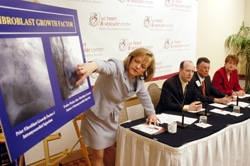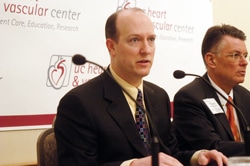Three patients of the UC Heart & Vascular Center have grown new coronary artery branches to increase blood flow to the heart after receiving a new growth factor protein (FGF1) in November 2003. All three patients showed improved blood flow to the heart twelve weeks following the injection.
Professor Thomas Stegmann, MD, chief of cardiovascular surgery at Fulda Medical Center in Fulda, Germany, has worked on the discovery and development of this growth factor for the past 10 years, and performed the first procedure in the world.
"Some people have such incapacitating chest pain and severe coronary artery disease where conventional treatments such as stents or bypass operations aren't an option for them.
 |
| Lynne Wagoner, MD, described the angiogenesis procedure at a press conference Thurs., March 25. |
Angiogenesis represents a promising treatment alternative," said Lynne E. Wagoner, MD, associate professor of medicine at the UC College of Medicine, director of cardiac services at The University Hospital and principal investigator of the trial.
"UC was pleased to be the first center in the nation to offer the growth factor protein treatment to patients. Stegmann's European results are compelling, and the UC Heart & Vascular Center wants to help bring this treatment to fruition here in the United States," Wagoner continued. "Our early results are exciting, but the research must continue. It is important to complete this clinical trial and evaluate our results with that of the other American centers."
Angina is a debilitating chest pain that affects more than 6 million Americans. It is caused by a lack of blood flow and oxygen to the heart muscle known as coronary artery disease. This reduction in blood flow and oxygen may result in damage to the heart muscle which can lead to heart failure. Angina is often managed by medication and in more severe cases with angioplasty, stenting and/or coronary artery bypass surgery. Angiogenesis treatment is an important breakthrough for patients that have run out of these options and are at-risk of developing heart failure.
The Patients
Constance Donley, age 51, of Cold Spring, Kentucky was the first patient in the United States to receive the FGF1 injection in November 2003. Donley began suffering severe angina following the first of three open-heart procedures in 1998. A medical records clerk at Deaconess Hospital, Donley found it hard to work a full day, crippled by her constant chest pain. Now, twelve weeks later the results are promising. "I feel great," said Donley. The mother of five smiled as she reported, "I am back at work full time and doing more and more everyday."
Claudia Robertson, age 54, of Kettering, Ohio, near Dayton was the second patient to undergo treatment. Robertson developed severe angina a few months after her 1999 emergency quadruple bypass. The mother of three, grandmother of three, is now back to playing trivia on Wednesday nights and shopping around town.
James Duke, age 57, of Forest Park, Ohio was the third patient to receive treatment. Duke developed severe angina also after a quadruple bypass in June 2002. The father of three, he is delighted to have received the option of angiogenesis treatment. "I am glad it was available to me," said Duke. He is now happy to be back at work for the Winton Woods School District.
The Procedure
Patients are invited to participate in the clinical trial after meeting stringent criteria. Dr. Wagoner,
 |
| Daniel Snavely, MD, is an interventional cardiologist at UC and manages the pre- and post-procedure patient evaluations. |
Daniel Snavely, MD, assistant professor and interventional cardiologist at UC and Walter H. Merrill, MD, professor and chief of UC cardiothoracic surgery, work together to conduct tests that determine if standard therapy is no longer an option for patients and if they have appropriate areas on their heart to receive the injection of the growth factor protein.
Dr. Merrill, injects FGF1 directly into the heart muscle of the patient. During the procedure, patients receive up to two injections of the growth factor protein during minimally-invasive, beating-heart surgery. Supplementing the heart with the growth factor protein can result in the growth of new arteries, which in turn provides alternate routes for oxygenated blood to reach the heart muscle.
The Results
Patients are evaluated through cardiac catheterizations screenings three months following the injection. Dr. Snavely, uses angiographic dye to detect any new artery growth. In the first three patients enrolled in the trial, FGF1 did, in fact, lead to new vessel formation and can be seen as a "blush" during cardiac catheterization. New arteries result in more blood flow, and therefore oxygen, delivered to the heart muscle. All patients are reporting little or no chest pain and the ability to do more physical activity than before receiving the injection.
The Impact
Coronary Artery Disease affects 12 million Americans. It is estimated that the direct and indirect costs of coronary disease is more than $100 billion per year in this country. The use of the FGF1 growth factor protein may also have significant application in the treatment of stroke or other problems consisting of decreased blood flow to the brain, or in peripheral vascular disease when there is diminished blood flow to the legs.
"This is an exciting new therapeutic option for patients whose health cannot be improved by any other means. Angiogenesis holds great potential to benefit patients who are severely impaired and have very little in the way of alternative treatment options. This process is also exciting for us as doctors, because it represents important collaborations between medical and surgical specialties that results in a spectrum of extraordinary care for patients with advanced heart disease," said Dr. Merrill.